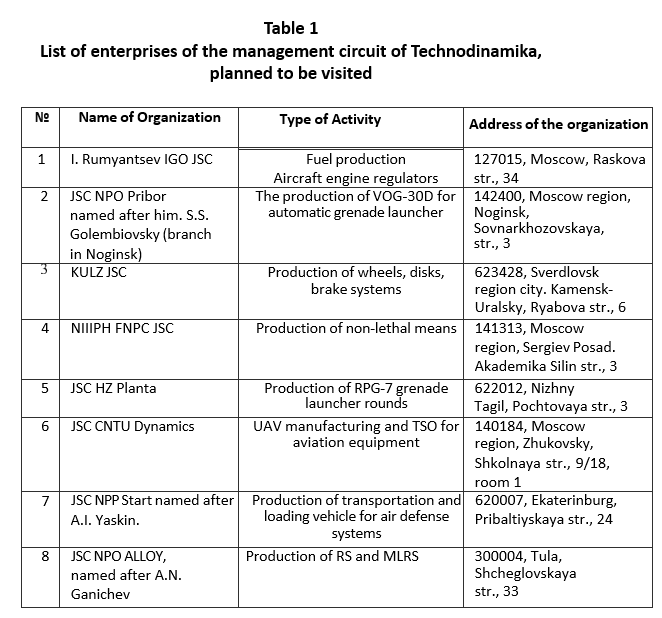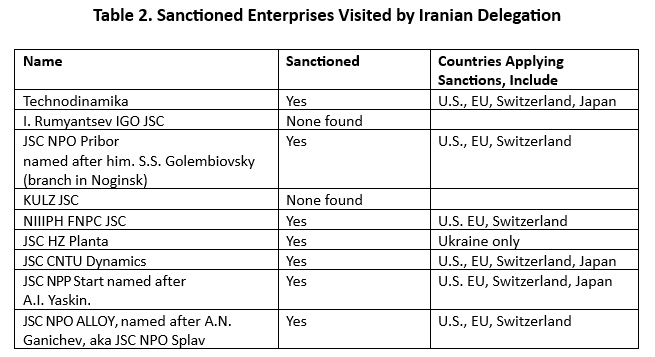Latest Reports
Iran/Russia Military Technology Axis: Russia Showcases to Iran New and Advanced Military Technology
by David Albright and Spencer Faragasso
June 25, 2024
A dangerous new weapons technology partnership between Iran and Russia is emerging with deadly consequences for the United States, Israel, and their allies. This axis, helped importantly by China, exchanges finished military hardware and the technology to replicate and produce it.
With the advent of Russia’s invasion of Ukraine, the transfer of weapons technology from Iran to Russia has developed on a large scale. The Ukraine war has led Russia to seek goods from Iran, including prominently a $1.75 billion purchase of Shahed 136 kamikaze drones and their production know-how. As it produces the Shahed drones, known in Russia as the Geran 2 drone, Russia has improved it. Based on the extensive interactions in Iran and in Russia between Iranian experts and the drone manufacturer, JSC Alabuga, there are grounds to believe that Russian improvements in the drone’s design and production have filtered back to Iran. Additionally, Iran is interested more generally in Russian military technologies.
A four-page document from a set of files hacked by the PRANA Network1 shows Iran’s broader interest in acquiring Russian military goods and technology from Technodinamika. Iran’s interests include rocket-propelled grenades (RPGs), aircraft parts, unmanned aerial vehicles (UAV) manufacturing, production of rocket launchers, including multiple launch rocket systems (MLRS), and air defense transports. Parts of this document were discussed in an April 15, 2024, Washington Post article, to which the Institute contributed.2 This report discusses the document in far greater detail.
The document describes a 17-person Iranian delegation visit to Russia from March 5 to March 13, 2023, aimed at familiarizing themselves with the “scientific and technical potential and production capabilities of JSC Technodinamika.” This company includes more than 100 enterprises and is part of the larger group, Rostec, billed as the Russian state-owned defense conglomerate focused on the promotion of the development, manufacture, and export of high-technology products.
Although Technodinamika publicly promotes the development, production, and export of high-technology products for civil aviation markets, its holdings produce a variety of military and dual-use goods. Its actions in supplying the Russian Armed Forces led to it being sanctioned by several countries, including the United States, the European Union, and Switzerland. According to Swiss authorities’ justification for their sanctions on Technodinamika, this holding company is a “weapons, ammunition, chemistry and aviation products manufacturer, and military provider of the Armed Forces of the Russian Federation.”3 They added that its subsidiary companies “manufactured KBLA-IVC unmanned aerial vehicles, ISDM Zemledeliye mine-laying systems and ammunition for rockets employed in BM-27 Uragan launchers, Vikhr guided aircraft missiles and Tornado-S rocket artillery systems, that were used by the Russian Armed Forces during Russia’s war of aggression against Ukraine.”
The document describes the schedule of the Iranian delegation to visit several Technodinamika subsidiaries and delineates the responsibility for the costs of each aspect of the program. At the top of the first page, I.G. Nasenkov,4 General Director of JSC Technodinamika, signed his agreement to the program, and E.V. Shmyrin, the Head of the Department of Advanced Intermilitary Research and Special Projects of the Russian Ministry of Defense, approved it.5 The visit was largely paid for by Technodinamika and its subsidiaries; Iran paid for the delegation’s roundtrip flights to Moscow and for their hotel stays in Moscow.
Which Technodinamika subsidiaries did the Iranian delegation plan to visit?
The document contains both a day-by-day program schedule and a table in Annex 1, titled “List of enterprises of the management circuit of Technodinamika S.A. to be visited.” Table 1 is a translation of the table in Annex 1 of the original document, listing the names of the companies the Iranian delegates visited, the companies’ activities of main interest to Iran, and the companies’ addresses.
The Iranian delegation arrived in Moscow on March 5, 2023, and checked into their Ibis brand hotel, a subsidiary of Accor S.A., a French hospitality company.6 During its first full day, March 6, 2023, the Iranian delegation heard initial multimedia presentations at Technodinamika’s headquarters in Moscow on its holdings’ competencies, and then visited two enterprises in the Moscow region, Rumyantsev IGO JSC and JSC NPO Pribor. The delegation then split into two groups and visited the rest of the companies in Table 1.
Group 1 flew to Ekaterinburg, aka Yekaterinburg, and visited KULZ JSC, JSC HZ Planta, and JSC NPP START. Group 2 remained in Moscow and visited NIIPH FNPC, JSC CNTU Dynamics, and JSC NPO Alloy.
A trip report was not included in the hacked documents, so it is unclear what was discussed in the visits or sold to Iran’s military or defense industries. Nonetheless, the document at hand is instructive to delve into individual Technodinamika companies, their products and services, and the activities of interest to Iran as listed in Table 1.
Table 2 shows which of Technodinamika’s enterprises in Table 1 are sanctioned. As can be seen, six of the eight are sanctioned. Five of these enterprises are sanctioned by the United States and the European Union, among others. In the sixth one, only Ukraine appears to apply sanctions. The two companies which are not sanctioned deserve to be.


Rumyantsev IGO JSC (АО «МПО им. И.Румянцева») The company is a Russian supplier of aircraft fuel and engine-related products, such as fuel pumps, regulators for aircraft engines and fuel injection. It is involved in supplying parts for military aircraft, including jets and long-range bombers. According to its website, it is “a leading manufacturer of equipment for fuel and hydraulic systems of aircraft, gas turbine engines for various purposes, pneumatic equipment for armored and special ground vehicles.” A more detailed list of its current aviation products includes plunger and afterburner pumps, pump regulators for MiG-29 and Su-27 aircraft, multifunctional command and fuel units for Tu-95 and An-22 aircraft, fuel units for the An-148 aircraft, command and fuel units for the Be-12, Il-38, and An-32 aircraft.
In Table 1, Iran expressed interest in fuel production and aircraft engine regulators. However, the document does not state which Iranian aircraft would receive these parts. Nonetheless, Iran has a wide variety of Russian, Western, and indigenous combat, military transport, and support aircraft. It has MiG-29 “Fulcrums,” Su-22, Su-24 “Fencers,” and recently received the Yak-130 combat trainer. It also has An-74 and Il-76 military transport aircraft. It is also seeking the Su-35 fifth-generation aircraft.
JSC NPO Pribor named after S.S. Golembiovsky (branch in Noginsk) (АО «НПО «Прибор» им. С.С. Голембиовского» (филиал в г. Ногинске))
This company is a leading developer of sub-caliber ammunition in the Russian Federation. The Bogorodsk branch of JSC NPO Pribor (Noginsk) is engaged in the design and manufacture of dies and molds, and it produces machine tools and accessories and powder metallurgy products. Its products include ammunition and explosives, and technology to make molds and dies for ammunition and explosives.
Table 1 specifically mentions Iran’s interest in the production of the VOG-30D, an enhanced lethality high explosive (HE) grenade, for an automatic grenade launcher.
Kamensk-Uralsky Foundry JSC (KULZ) (АО “КУЛЗ”)
The company is one of the country’s largest manufacturers of aircraft wheels and control units. It specializes in manufacturing aircraft brake wheels for civil and military aviation and brake control units. The company manufactures wheels for fighter jets and trainers, such as the fifth-generation T-50 aircraft, Yak-130, MiG-29K, MiG-29KUB, MiG-29SMT, and others. Interestingly, this visit seems to complement reporting in early 2023 of Iranian interest in fifth generation fighter jets. While reporting at the time focused specifically on the Su-35, Iran later received the Yak-130 trainer jet.
Table 1 shows Iran’s interest in the production of wheels, disks, and brake systems.
NIIIPH FNPC JSC (АО «ФНПЦ «НИИПХ»)
The company is a Russian “pyrotechnics” developer. The company appears to produce flares, flash grenades, fireworks, and ammunition. According to the Russian language version of Wikipedia: “The range of special pyrotechnic products developed, adopted for service and put into production since 1945, intended to equip all branches of the military, exceeds 550 items, including more than 200 pyrotechnic products (igniters, solid fuel charges, pyro-automatic means) used in rocket, missile, and artillery systems.” Products include ammunition and explosives, non-lethal antipersonnel devices, such as tasers, flash grenades, and explosive charges.
Iran expressed interest in the production of “non-lethal means,” which could refer to nonlethal antipersonnel devices. These could be used by Iranian authorities to violently suppress protesters.
JSC HZ Planta (АО «ХЗ «Планта»)
According to Ukraine’s sanctions designation for this company, it is involved in the development, production, and export of high-tech industrial products, and in the production of weapons and ammunition for the needs of the military-industrial complex of the Russian Federation.7
Table 1 lists Iran’s interest as the production of RPG-7 grenade launcher rounds.
JSC CNTU Dynamics (АО ЦНТУ «Динамика»)
This company is a developer of UAV systems for the Russian market and military. According to its own descriptions, since 2013, it has invested in unmanned aircraft technologies, in particular the creation of prototypes and the production of UAVs of various aerodynamic designs with many applications. It also makes aviation simulators and dummy drones. More specifically, it makes target UAVs, develops and produces aviation simulators and training systems for training aircraft and helicopter crews, and produces engineering simulators in support of the research and design of advanced aircraft.
Table 1 lists Iran’s interests as “UAV manufacturing and TSO for aviation equipment.” TSO likely stands for Technical Standard Order. In the United States, a TSO is a minimum performance standard for specified materials, parts, processes, and appliances used on civil aircraft, and the standards are important in production and quality control processes.
JSC NPP Start, named after A.I. Yaskin (“АО «НПП «Старт» им. А.И. Яскина»)
The company, formerly called the State Design Bureau of Compressor Engineering of the Ministry of Aviation Industry, develops a range of military systems. It produces a variety of weapons systems, including multiple launch missile rocket systems (MLRS), air defense and missile defense launchers, ship-based missile launchers, aviation missile launchers, ground support systems, and ground support complexes for sea and air-based missile systems, as well as transport-loading vehicles for the Tor, BUK, S-300, S-400 anti-aircraft missile systems.8
Table 1 lists the activities of interest to Iran as “production of transportation and loading vehicles for air defense systems.”
JSC NPO ALLOY, named after A.N. Ganichev (АО «НПО «СПЛАВ» им. А.Н.Ганичева»)
The company, aka JSC NPO Splav, has created a number of weapon systems, including MLRS in the interests of the Russian Ground Forces, Navy, and Air Forces (BM-21 Grad, BM-27 Uragan, BM-30 Smerch, Tornado MRL, TOS-1A, Boa constrictor-1M, Fire, and DP-62 Dam). It claims it exports its products to more than 50 countries around the world, but this claim is unlikely to be true today. It also works on multifunctional frequency synthesizers for airborne radars.
Iran expressed interest in the production of RS and MLRS. RS may stand for rocket systems.
1. On 4 February 2024, PRANA Network announced its successful hack of the email servers of an IRGC front company named Sahara Thunder which was facilitating Iran’s sale of Shahed 136 drone technology to Russia, https://irancybernews.org/irgc-front-company-sahara-thunder-hacked-by-prana-network/. </a ↩
2. Joby Warrick, “Russian weapons help Iran harden defenses against Israeli airstrike,” The Washington Post, April 15, 2024, https://www.washingtonpost.com/national-security/2024/04/15/iran-israel-russia-drones-missiles/. The Institute could not verify the authenticity of the document discussed here, but it is a key file in the collection of leaked PRANA documents discussed in the Washington Post article. To that point, the Washington Post referenced two Biden administration officials as acknowledging that “U.S. intelligence agencies have closely studied the leaked materials and do not dispute their authenticity.” ↩
3. “Joint Stock Company Technodinamika: Switzerland Sanctions as Per Swiss SECO - State Secretariat for Economic Affairs,” Open Sanctions, April 20, 2023, https://www.opensanctions.org/entities/NK-fq4GNFzLgn5w3nfkvZy3xT/ ↩
4. See, https://www.reflector.com/news/world/russia-military-putin/image_37e187d4-4f9e-53b4-b349-1f49dff9d81c.html. ↩
5. On the bottom of page 3, there are also the signatures of A.A. Podolsky, Deputy Director General for Foreign Economic Activity, and A.A. Polyakov, Deputy Director of Economics and Finance. ↩
6. Accor S.A., while it has suspended new investments, has not divested from the Russian market and continues to operate its Ibis brand hotels in the country. See: https://leave-russia.org/accor#:~:text=According%20to%20press%2C%20the%20company,to%20by%20more%20stringent%20sanctions. ↩
7. https://sanctions.nazk.gov.ua/en/sanction-person/5594/. ↩
8. https://ru.wikipedia.org/wiki/%D0%A1%D1%82%D0%B0%D1%80%D1%82_(%D0%9D%D0%9F%D0%9F). ↩
 twitter
twitter




